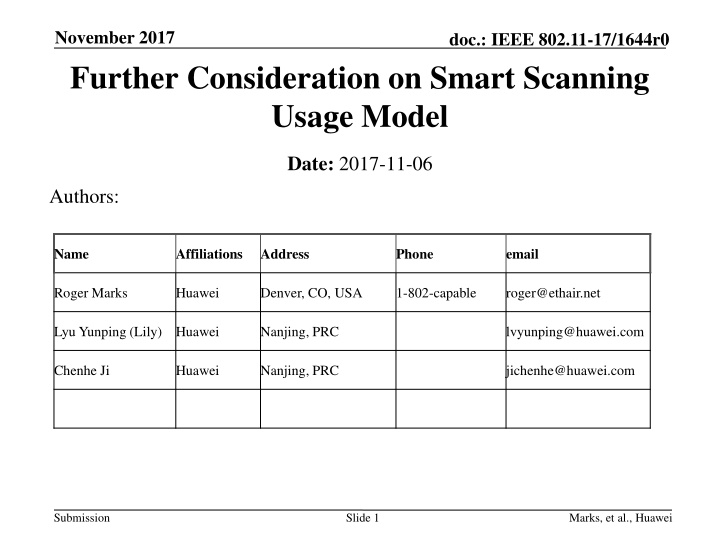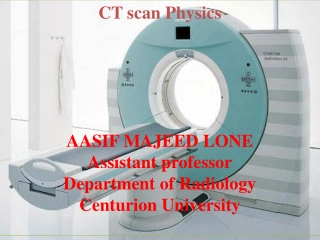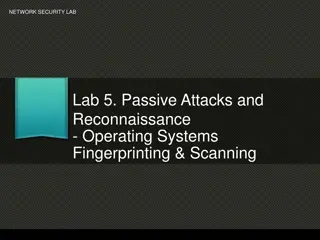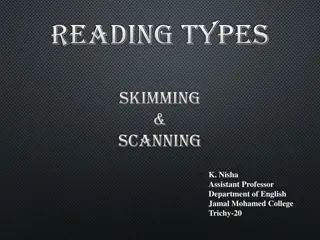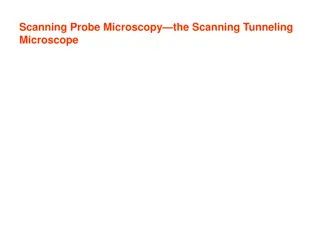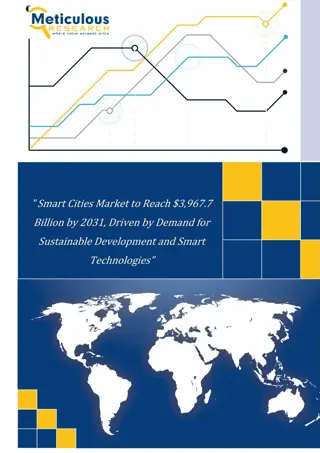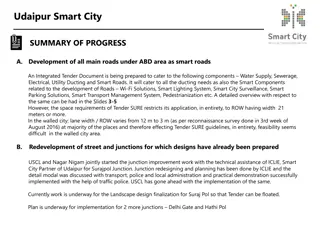Further Consideration on Smart Scanning Usage Model
This document outlines the Smart Scanning Usage Model proposed by Huawei for IEEE 802.11 TGba, focusing on offloading passive background scans to ultra-low-power receivers to conserve energy. It delves into two key use cases: Ultra-low-power roam scan for mobile devices and ultra-low-power location scan for improved location services. By leveraging the WUR technology, this model aims to reduce roaming latency and power consumption significantly in wireless networks.
Download Presentation

Please find below an Image/Link to download the presentation.
The content on the website is provided AS IS for your information and personal use only. It may not be sold, licensed, or shared on other websites without obtaining consent from the author.If you encounter any issues during the download, it is possible that the publisher has removed the file from their server.
You are allowed to download the files provided on this website for personal or commercial use, subject to the condition that they are used lawfully. All files are the property of their respective owners.
The content on the website is provided AS IS for your information and personal use only. It may not be sold, licensed, or shared on other websites without obtaining consent from the author.
E N D
Presentation Transcript
November 2017 Further Consideration on Smart Scanning Usage Model doc.: IEEE 802.11-17/1644r0 Date: 2017-11-06 Authors: Name Affiliations Address Phone email Roger Marks Huawei Denver, CO, USA 1-802-capable roger@ethair.net Lyu Yunping (Lily) Huawei Nanjing, PRC lvyunping@huawei.com Chenhe Ji Huawei Nanjing, PRC jichenhe@huawei.com Submission Slide 1 Marks, et al., Huawei
November 2017 doc.: IEEE 802.11-17/1644r0 Abstract This contribution, intended for presentation to IEEE 802.11 TGba, proposing additional details to apply Usage Model 9 ( Smart Scanning ) of the WUR Usage Model Document (IEEE 802.11-17/0029r10), consistent with the Specification Framework for TGba (IEEE 802.11-17/0575r04). The key points are: advertisement of the WUR scan channel benefits of implementing with a shared scan channel Submission Slide 2 Marks, et al., Huawei
November 2017 doc.: IEEE 802.11-17/1644r0 Background The WUR Usage Model Document, in Revision 10 (IEEE 802.11-17/0029r10), introduced a new Usage Model 9 ( Smart Scanning ), with two use cases, based on IEEE 802.11-17/1386r7. discovering nearby APs on main radio requires the STA to do passive or active scan which consumes quite some power Since WUR is an ultra-low power receiver, offloading some of the passive background scans to WUR can significantly save even more power [17/1386r7] Submission 3 Marks, et al., Huawei
Sept 2017 November 2017 doc.: IEEE 802.11-17/1644r0 Usage Model 9: Smart Scanning Use case 2: Ultra low power roam scan Mobile devices sometime scan for roaming purposes. These roam scan sometimes is triggered when link quality degrades. These roam scan takes time because the scan is typically done on multiple channels, and on each channel the device either conducts active scan during which it sends a probe request and typically stays awake until it receives a probe response, or passive scan during which it dwells on each channel for at least a Beacon interval to receive a Beacon. As a consequence, scanning through multiple channels introduces roaming latency and consumes power. Sometimes, it runs into conflict with regular data exchange. Use case 1: Ultra-low power location scan Mobile devices sometimes scan through multiple channels for nearby APs, and use the measured Wi-Fi signal strength for improved location services. In addition, scanning on main radio has the risk of conflicting with regular data exchange. In WUR-facilitated location scan, the mobile device scans through the channels using the WUR receiver, and uses the signal strength measured from WUR packets received from adjacent APs to provide additional information to the location services on the mobile device. In other words, some of the location scan on main radio can be offloaded to WUR radio. In WUR-facilitated roam scan, the mobile device passively scans through multiple channels using WUR, and collects basic information about nearby APs. The collected info can be used to facilitate the devices roaming decisions. Because WUR consumes much less power than main radio, WUR- facilitated roam scan provides an ultra-low power roam scan. In addition, due to the low power operation, WUR scan can be performed quite frequently in the background, and thus roaming information can be readily available whenever needed, i.e., it reduces roaming latency. Because WUR consumes much less power than main radio, WUR facilitated location scan provides an ultra-low power location scan mechanism. Submission Slide 4 Marks, et al., Huawei
November 2017 doc.: IEEE 802.11-17/1644r0 Smart Scanning Usage Model is Distinctive As explained in IEEE 802.11-17/1386r7, Smart Scanning differs from the other usage models: Intended for smart phones, etc., rather than IoT. Does not attain power saving from main radio sleep. for mainstream devices, the main radio cannot be turned off completely [17/1386r7] scanning on main radio has the risk of conflicting with regular data exchange [17/0029r10, Usage Model 9] Note: Consistent with PAR (which says The reception of the wake- up frame by the WUR can trigger a transition of the primary connectivity radio out of sleep. ) Submission 5 Marks, et al., Huawei
November 2017 doc.: IEEE 802.11-17/1644r0 Usage Model 9: Key Aspects devices sometimes scan through multiple channels for nearby APs, and use the measured Wi-Fi signal strength for improved location services. scanning on main radio has the risk of conflicting with regular data exchange implies that scanning on WUR does not conflict implies that WUR transmission and reception are simultaneous with primary (PCR) radio In WUR-facilitated location scan, the mobile device scans through the channels using the WUR receiver, and uses the signal strength measured from WUR packets received from adjacent APs roam scan takes time because scanning through multiple channels introduces roaming latency and consumes power. In WUR-facilitated roam scan, the mobile device passively scans through multiple channels using WUR, and collects basic information about nearby APs. WUR scan can be performed quite frequently in the background, and thus roaming information can be readily available whenever needed, i.e., it reduces roaming latency Submission 6 Marks, et al., Huawei
November 2017 doc.: IEEE 802.11-17/1644r0 Usage Model 9: Some Open Questions 1. 802.11ba should define frame format that allows unassociated STAs to interpret the AP s identity [per 17/1386r7] 2. What is the WUR scanning channel, and how does the mobile know it? 3. How do we deal with legacy APs and mobiles? 4. Should active scanning be included? 5. Can we improve the latency and efficiency further by using a shared WUR channel? Submission 7 Marks, et al., Huawei
November 2017 doc.: IEEE 802.11-17/1644r0 Drawing from a Prior Contribution on Smart Scanning Prior TGmd contribution IEEE 802.11-17/0666r2 proposed to improve scanning efficiency and latency, without WUR 17/0666r2 concepts address the gaps in Usage Model 9 Key points of IEEE 802.11-17/0666r2 the 802.11ai Reduced Neighbor Report (RNR) advertises the channel on which neighbors provide scanning info the advertisement is flagged using a reserved value the RNR in the TBTT Information Field Type (TIFT) subfield three of the four values are currently reserved suggests reducing scanning latency by providing scanning info in a single shared channel Submission 8 Marks, et al., Huawei
doc.: IEEE 802.11-17/1644r0 What is TBTT Information Field Type (TIFT)? Submission 9
November 2017 doc.: IEEE 802.11-17/1644r0 Usage Model 9: Some Directions 1. 802.11ba should define frame format that allows unassociated STAs to interpret the AP s identity [17/1386r7] We agree with 17/1386r7. The AP s PCR channel should be part of its identity. 2. What is the WUR channel, and how does the mobile know it? The AP can advertise the WUR scanning channel in the reduced neighbor report (RNR), identifying it as WUR using a specified value of the TIFT parameter. 3. How do we deal with legacy APs and mobiles? Legacy scanning procedures can remain in place. Mobile knows from RNR whether WUR scanning is enabled. 4. Should active scanning be included? Possible; probe request can use main radio or WUR. Improves latency but adds complexity. 5. Can we improve the latency and efficiency further if multiple APs share a WUR scanning channel? Yes; if APs use a shared WUR scanning channel, then mobile needs to probe only that channel instead of the channel of each AP. Reduces both latency and energy. Submission 10 Marks, et al., Huawei
November 2017 doc.: IEEE 802.11-17/1644r0 WUR Channel Considerations Per contribution IEEE 802.11-17/1333r2, TGba agreed that AP decides the WUR operating channel 17/1333r2 presented these views: operating channel of primary radio (PCR) and WUR may differ STA may only support WUR in 2.4 GHz band for low power/cost implementation, and a dual-band concurrent AP can use 2.4 GHz band and channel as the operating channel of WUR even if PCR operating channel is in 5 GHz band AP can indicate [WUR operating channel] in beacon for other applications like AP discovery a common channel may be required for simplifying the scan requirement 17/1608r0 proposed to define Discovery Channel concept for WUR transmitter to send out WUR discovery frames 17/0666r2 presented the same views regarding the use of a dedicated scanning channel Submission 11 Marks, et al., Huawei
November 2017 doc.: IEEE 802.11-17/1644r0 Smart Scanning with RNR Identification Submission 12 Marks, et al., Huawei
November 2017 doc.: IEEE 802.11-17/1644r0 Usage Model 9: Basic Submission 13 Marks, et al., Huawei
November 2017 doc.: IEEE 802.11-17/1644r0 Usage Model 9, Advertised Scan Channels Submission 14 Marks, et al., Huawei
November 2017 doc.: IEEE 802.11-17/1644r0 Usage Model 9, Shared Scan Channel Submission 15 Marks, et al., Huawei
November 2017 doc.: IEEE 802.11-17/1644r0 Usage Model 9: Active Scan Submission 16 Marks, et al., Huawei
November 2017 doc.: IEEE 802.11-17/1644r0 Usage Model 9 with Multiple Scan Channels Submission 17 Marks, et al., Huawei
November 2017 doc.: IEEE 802.11-17/1644r0 Usage Model 9 with Multiple Scan Channels Submission 18 Marks, et al., Huawei
November 2017 doc.: IEEE 802.11-17/1644r0 Usage Model 9 with Shared Scan Channel Submission 19 Marks, et al., Huawei
November 2017 doc.: IEEE 802.11-17/1644r0 Congestion in the ScanChannel Per IEEE 802.11-17/1386r7, Use Case 1 (location scan) of Usage Model 9, WAI period can be tens of seconds passive scanning with low WAI repetition rate In Use Case 2 (roam scan) of Usage Model 9, latency is critical passive scanning with high WAI repetition rate (~100 ms), or active WAI duration can be around 1-2 ms frame data content could be as little as ~12 bytes identify the operating channel and the ESS 0.4 ms at 250 kbit/s or 1.5 ms at 62.5 kbit/s probably not long enough to be a major problem Submission Slide 20 Marks, et al., Huawei
November 2017 doc.: IEEE 802.11-17/1644r0 Summary Usage Model 9 stands in need of further detail IEEE 802.11-17/1333r2 and IEEE 802.11-17/0666r2 provide useful guidance Needs a means to inform mobile of the WUR scan channel the RNR element is a good basis need to add a tag to identify the channel If multiple APs use a common shared WUR scan channel, then scanning will be much faster Note: How APs choose their scan channels need not be standardized here. Perhaps they listen over the air; perhaps they are coordinated by a controller. Submission Slide 21 Marks, et al., Huawei
November 2017 doc.: IEEE 802.11-17/1644r0 References [1] IEEE 802.11-17/0029r10 ( WUR Usage Model Document ) [2] IEEE 802.11-17-0575r04 ( Specification Framework for TGba ) [3] IEEE 802.11-17/1386r7 ( Examining 11ba usage models for mainstream devices ) [4] IEEE 802.11-17/0666r2 ( TBTT Information Field Type (TIFT): Proposed content for 802.11REVmd ) [5] IEEE 802.11-17/1333r2 ( WUR Operating Channel ) [6] IEEE 802.11-17/1608r0( WUR Discovery Frame for Smart Scanning ) Submission Slide 22 Marks, et al., Huawei
